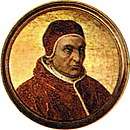1404 papal conclave
The 1404 papal conclave (October 10 to October 17) – the papal conclave of the time of the Great Western Schism, convened after the death of Pope Boniface IX, it elected Cardinal Cosimo Gentile Migliorati, who under the name of Innocent VII became the third pope of the Roman Obedience.
| Papal conclave October 1404 | |
|---|---|
| Dates and location | |
| 10–17 October 1404 Rome, Papal States | |
| Key officials | |
| Protodeacon | Ludovico Fieschi |
| Elected pope | |
| Cosimo de' Migliorati Name taken: Innocent VII | |
 | |
Cardinal electors
Pope Boniface IX died on October 1, 1404. At the time of his death, there were only 12 cardinals in the Roman Obedience of the Sacred College. Nine of them participated in the election of his successor:
| Elector | Order and titular church | Elevated | Elevator | Notes |
|---|---|---|---|---|
| Angelo Acciaioli | Cardinal-Priest of S. Lorenzo in Damaso | 1384, December 17 | Urban VI | |
| Francesco Carbone Tomacelli, O.Cist. | Cardinal-Priest of S. Susanna | 1384, December 17 | Urban VI | Grand penitentiary; Archpriest of the patriarchal Lateran Basilica |
| Angelo d'Anna de Sommariva, O.S.B.Cam. | Cardinal-Priest of S. Pudenziana | 1384, December 17 | Urban VI | |
| Enrico Minutolo | Cardinal-Priest of S. Anastasia | 1389, December 18 | Boniface IX | Archpriest of the patriarchal Liberian Basilica; Camerlengo of the Sacred College of Cardinals |
| Cosimo Gentile Migliorati (elected Pope Innocent VII) | Cardinal-Priest of S. Croce in Gerusalemme | 1389, December 18 | Boniface IX | |
| Cristoforo Maroni | Cardinal-Priest of S. Ciriaco | 1389, December 18 | Boniface IX | Archpriest of the patriarchal Vatican Basilica |
| Antonio Caetani (seniore) | Cardinal-Priest of S. Cecilia | 1402, February 27 | Boniface IX | |
| Landolfo Maramaldo | Cardinal-Deacon of S. Nicola in Carcere Tulliano | 1381, December 21 | Urban VI | |
| Rinaldo Brancaccio | Cardinal-Deacon of SS. Vito e Modesto | 1384, December 17 | Urban VI |
All the electors were Italians. Five of them were elevated by Pope Urban VI, and four by Boniface IX.
Camerlengo of the Holy Roman Church was at that time Corrado Caraccioli, bishop of Mileto.
Absentee cardinals
Three cardinals, two created by Urban VI and one by Boniface IX, did not participate in this conclave:
| Elector | Order and titular church | Elevated | Elevator | Notes |
|---|---|---|---|---|
| Bálint Alsáni | Cardinal-Priest of S. Sabina | 1384, December 17 | Urban VI | Archpriest of the Sacred College of Cardinals; Administrator of the see of Pécs |
| Ludovico Fieschi | Cardinal-Deacon of S. Adriano | 1384, December 17 | Urban VI | Protodeacon of the Sacred College of Cardinals; Administrator of the see of Vercelli |
| Baldassare Cossa | Cardinal-Deacon of S. Eustachio | 1402, February 27 | Boniface IX | Legate in Romagna and Bologna |
Hungarian Alsani was the only non-Italian Cardinal in the Roman Obedience.
The election of Pope Innocent VII
Several churchmen and laymen urged "Roman" Cardinals not to elect the successor of Boniface IX and to recognise Benedict XIII of Avignon as Pope (or, at least, to wait for his death and then elect the new pope together with his adherents). Among the supporters of this point of view was Cardinal Protodeacon Ludovico Fieschi, who did not attend the conclave and later did not recognise its result.
In spite of this, nine cardinals present in Rome entered the conclave on October 10. Initially, they subscribed the conclave capitulation, which obliged elect to do everything possible (including abdication) in order to restore the unity of the Church. After seven days of deliberations Cardinal Cosimo Gentile Migliorati was unanimously elected pope and took the name of Innocent VII. Five days later Cardinal Fieschi officially abandoned the Roman Obedience[1] and recognised Benedict XIII as true pope, so the rite of papal coronation on November 11 was performed by the new Protodeacon Landolfo Maramaldo.[2]
Bibliography
- Martin Souchon: Die Papstwahlen in der Zeit des grossen Schismas, Verlag von Benno Goeritz, 1888